Luang Prabang
Nestling in a slim valley shaped by lofty, green mountains and cut by the swift Mekong and Khan rivers, LUANG PRABANG exudes tranquillity and casual grandeur. A tiny mountain kingdom for more than a thousand years and designated a UNESCO World Heritage Site in 1995, Luang Prabang is endowed with a legacy of ancient red-roofed temples and French-Indochinese architecture, not to mention some of the country’s most refined cuisine, its richest culture and its most sacred Buddha image, the Pha Bang. For those familiar with Southeast Asia, the very name Luang Prabang conjures up the classic image of Laos – streets of ochre colonial houses and swaying palms, lines of saffron-robed monks gliding through the morning mist, the sonorous thump of the temple drums before dawn, and, of course, longtail boats racing down the Mekong before the river slips out of view through a seam in the mountains.
It is this heritage of Theravada Buddhist temples, French–Indochinese shophouses and royal mystique that lends Luang Prabang a pull unmatched by any other city in Laos. This is not only where the first proto-Lao nation took root, it’s also the birthplace of countless Lao rituals and the origin of a line of rulers, including the rulers of Vientiane, Champasak and Lane Xang. Luang Prabang people are tremendously proud of their pivotal role in Lao history. Indeed, they’re somewhat known for their cultured ways in the rest of the country; in Lao soap operas, the doctor or the intellectual invariably speaks with a Luang Prabang accent.
Luang Prabang’s strict building code, drawn up by UNESCO, keeps it from becoming another modern architectural nightmare without turning it into a museum. Inevitably, the city has lost some of its sleepy charm and dreamy serenity as a result of the growing influx of tourists, but exploring the side streets and dusty lanes, its not hard to feel as though you’ve stepped into the city of yesteryear. Parts of the city do already feel over touristy – indeed, on stretches of Sisavangvong Road, were it not for the unmistakable architecture, you could be anywhere else on the well-trodden Southeast Asian tourist trail – especially when you’ve come from other parts of the country where tourism is still a novelty. Though the city remains surprisingly laidback, with none of the hassle associated with other parts of Asia, an airport expansion is due in 2013, which will allow larger planes to fly in and out of Luang Prabang, meaning the small-town charms of this beautiful city could be encroached on further.
Here are 15 attractive destinations in Luang Prabang you should not miss:
1. The old quarter
The old quater is concentrated on a long finger of land, approximately 1km long by 300m wide. The thicker southern end of the peninsula is dominated by a steep, forested hill, Phousi, crowned by a Buddhist stupa that can be seen for miles around. As the city grew it expanded outwards from the peninsula to the south and east, and continues to do so to this day.
Just four parallel streets run the length of the peninsula, but there are enough cross streets, lanes and dead ends to keep things interesting. Amazingly, each area seems to exude its own distinct personality. Although it is possible to knock off all the attractions in the old quarter in a couple of days, it’s far more enjoyable to explore it a little at a time, and really soak up the atmosphere; the many temples and monasteries are certainly too charming be rushed through.
Photo: tripadvisor.co.uk
2. Phousi
Phousi (Sacred Hill) is the geographical as well as spiritual centre of the city. Believed to have once harboured a powerful naga who dwelt in its bowels, the hill is also seen as a miniature Mount Meru, the Mount Olympus of Hindu-Buddhist cosmology. Though there is nothing to see on the hill itself, save for an ancient-looking sim at its foot, Phousi is striking from a distance. Indeed, the golden spires of That Chomsi at its summit are the first glimpse of the city that visitors get if they are arriving by boat or plane. Likewise, the peak affords a stunning panorama of the city it crowns, and the shimmering rivers and jungle-clad mountains beyond are mesmerizing. Viewing the setting sun from the summit of Phousi has become a kind of tourist ritual, so don’t expect to enjoy the moment alone – indeed, early morning is a better time to come, when the city and the hill are more peaceful. A quieter spot from which to watch the sunset is Santi Chedi on a hill due east of Phousi, which affords a marvellous view back towards Phousi, without the crowds.

Photo: tripadvisor.co.uk
There are three approaches to the summit. The first and most straightforward is via the stairway directly opposite the main gate of the Royal Palace Museum. The second approach, on the other side of the hill, is up a zigzag stairway flanked by whitewashed naga, and can be used for descending to Phousi Road. The third and most rambling approach is via Wat Pha Phoutthabat near Phousi’s northern foot (across from the Saynamkhan Riverview Hotel).
Most people choose the first ascent, which allows you to first stop at the adjacent Wat Pa Houak. This fine little temple, overlooking Sisavangvong Road and the Royal Palace Museum, has a charmingly weathered facade, but is mainly of interest of its interior murals. Though the French art historian Henri Parmentier once describing them as “ridiculous”, they are in fact fascinating, and appear to depict Luang Prabang as a celestial city. Besides Lao characters in classical costumes, there are Chinese, Persians and Europeans in the city, but it is not clear whether they have come as visitors or invaders. After soaking up the murals it’s a steep climb through a tunnel of shady plumeria trees to the peak.
3. The Royal Palace (Royal Palace Museum)
Occupying a fittingly central location in the old city, between Phousi Hill and the Mekong River, the former Royal Palace is now home to the Royal Palace Museum, preserving the trappings and paraphernalia of Laos’s recently extinguished monarchy. The palace, at the end of a long drive lined with stately palms, was constructed in 1904 by the French and replaced an older, smaller palace of teak and rosewood. The new palace was supposed to be crowned by a European-style steeple, but King Sisavang Vong insisted on modifications, and the graceful stupa-like spire that you see today was substituted, resulting in a tasteful fusion of European and Lao design. Another striking feature is the pediment over the main entrance adorned with a gilt rendition of the symbol of the Lao monarchy: Airavata, the three-headed elephant, being sheltered by the sacred white parasol. This is surrounded by the intertwining bodies of the fifteen guardian naga of Luang Prabang.
The king’s reception room, to the right of the entrance hall, is full of huge Gauguinesque canvases portraying what appears to be “a day in the life of old Luang Prabang”, with scenes of the city as it appeared in the early twentieth century. The paintings, executed by Alex de Fautereau in 1930, are meant to be viewed at different hours of the day when the light from outside is supposed to illuminate the panels depicting the corresponding time of day.
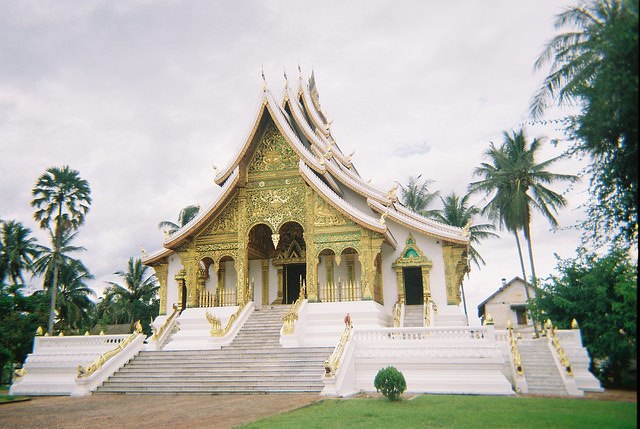
Photo: laostravelpackagetours.com
More impressive is the Throne Hall, just beyond the entry hall. Its high walls spangled with mosaics of multicoloured mirrors set in a crimson background, the throne hall dazzles even in the dim light. These mosaics, along with others at Wat Xieng Thong, were created in the mid-Fifties to commemorate the 2500th anniversary of the historic Buddha’s passing into Nirvana. On display in this room are rare articles of royal regalia: swords with hilts and scabbards of hammered silver and gold, an elaborately decorated fly-whisk and even the king’s own howdah (elephant saddle). Also on show is a cache of small crystal, silver and bronze Buddha images taken from the inner chamber of the “Watermelon Stupa” at Wat Visoun. Somehow these treasures escaped the plundering gangs of “Black Flag” Chinese who, led by a White Tai warlord, sacked Luang Prabang in 1887. The stupa was destroyed, rebuilt in 1898, but collapsed in 1914. It was then that the Buddhas were discovered inside.
Leaving the Throne Hall via the door on the right, you come to the royal library, which is almost exclusively made up of official archives of the Ming and Ching dynasties, a gift from China during the Cultural Revolution. The corridors that surround the rooms at the rear are decorated with sixteen pictures that illustrate the legend of Prince Wetsantara, considered an important epic by Lao Buddhists.
King Sisavang Vong’s bedchamber, located at the very back of the palace, is surprisingly modest. The only thing that looks especially regal is the massive hardwood bed, the headboard of which sports the king’s initials and a carved Buddha sheltered by a seven-headed naga. The footboard bears a rendition of the royal emblem of Laos, this time with a two-tiered parasol.
Of the two final rooms, the near room houses diplomatic gifts presented to the people of Laos by a handful of nations, as well as the rather tatty-looking flag of the Kingdom of Laos that was given a symbolic ride up into space and back on one of the Apollo missions. Not long afterwards, the Kingdom of Laos ceased to exist. In the far room hang larger-than-life portraits of King Sisavang Vattana, his wife Queen Kham Phoui and their son Prince Vong Savang. These are the only officially displayed portraits of the last members of the 600-year-old dynasty anywhere in Laos. Had they not been painted by a Soviet artist they almost certainly would not have survived the years following the revolution. The same goes for the bronze sculpture of King Sisavang Vong in the museum grounds near the front gate. This statue may look familiar if you have already passed through Vientiane, where a larger version stands in the park adjacent to Wat Simuang.
Turn left immediately upon exiting the museum to reach the small room that currently houses the Pha Bang, the most sacred Buddha image in Laos. Flanking the Pha Bang are numerous other Buddha images, including ancient Khmer stone images and several pairs of mounted elephant tusks. One pair, deeply incised with rows of Buddhas, was noted by Francis Garnier on the altar of Wat Visoun in the 1860s. Displayed nearby in richly carved wooden frames are silk panels embroidered with gold and silver thread that depict yet more images of the Buddha.
4. Wat Xieng Thong
The most historic and enchanting Buddhist monastery in the entire country, Wat Xieng Thong, the Golden City Monastery, should not be missed. Near the northernmost tip of the peninsula, the temple compound alone is a delight to wander through, especially early in the morning before the tourist crowds descend on it. The main temple or sim was built in 1560 by King Setthathilat (who then promptly moved the capital of the Kingdom of a Million Elephants downriver to Vientiane) and it is this wonderfully graceful building that dominates the monastery. Unlike nearly every other temple in Luang Prabang, this sim was not razed by Chinese marauders in the nineteenth century or overenthusiastically restored in the twentieth. Indeed, an old photograph taken under Auguste Pavie’s direction shows the temple to have changed little in the last century.
You’ll need to stand at a distance to get a view of the roof, the temple’s most outstanding feature. Elegant lines curve and overlap, sweeping nearly to the ground, and evoke a bird with outstretched wings or, as the locals say, a mother hen sheltering her brood. The walls of the sim are decorated inside and out with stencilled gold motifs on a black or maroon background. As you enter the dimly lit temple and your eyes adjust to the lack of light, the gold-leaf patterns seem to float on the blackened walls.
Besides stylized floral designs, the motifs depict a variety of tales, including the Lao version of the Ramayana, scenes from the Jataka and stories about the lives of the Buddha, as well as graphic scenes of punishments doled out in the many levels of Buddhist hell. In one of these punishment scenes, on the wall to the right of the main entrance, an adulterous couple is being forced to flee a pack of rabid dogs by climbing a tree studded with wicked thorns. Other unfortunate souls are being cooked in a copper cauldron of boiling oil (for committing murder) or are suspended by a hook through their tongues (guilty of telling lies).
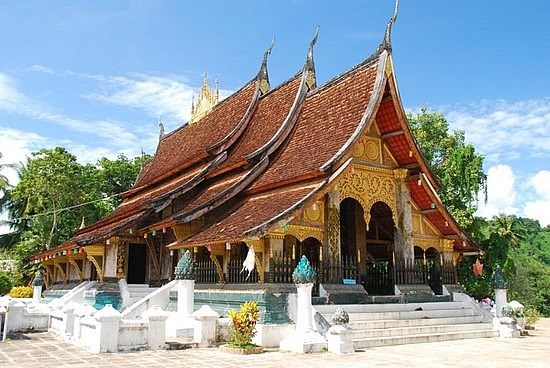
Photo: dulichlao.com.vn
In the rafters above and to the right of the main entrance runs a long wooden aqueduct or trough in the shape of a mythical serpent. During Lao New Year, lustral water is poured into a receptacle in the serpent’s tail and spouts from its mouth, bathing a Buddha image housed in a wooden pagoda-like structure situated near the altar. A drain in the floor of the pagoda channels the water through pipes under the floor of the sim and the water then pours from the mouth of a mirror-spangled elephant’s head located on the exterior wall.
Covering the exterior of the back wall of the sim is a mosaic, said to depict a legendary flame tree that stood on the site when the city was founded. This particular composition is especially beautiful during the Festival of Lights, when the sim is decked out with khom fai dao, star-shaped lanterns constructed of bamboo and mulberry paper. The flickering candlelight illuminates the tree and animals in the mosaic, making them twinkle magically.
To the left of the sim, as you face it, stands a small brick-and-stucco shrine containing a standing Buddha image. The purple and gold mirrored mosaics on the pediments of the structure are especially intricate and probably the country’s finest example of this kind of ornamentation, which is thought to have originated in Thailand and spread to Burma as well. Directly behind the shrine is a larger structure known to French art historians as “La Chapelle Rouge”, the Red Chapel. The reclining Buddha image enshrined within is one of Laos’s greatest sculptures in bronze.
5. The Pak Ou Buddha Caves and Whisky Village
A river excursion to the Pak Ou Buddha Caves, 25km north of Luang Prabang at the confluence of the Mekong and Nam Ou rivers, is one of the best quick trips you can make out of the city. Numerous caves punctuate the limestone cliffs on both sides of the Mekong in this vicinity, but the two “Buddha Caves” of Tham Ting and Tham Phoum are the best known. These caves have been used for centuries as a repository for old Buddha images that can no longer be venerated on an altar, either because they are damaged to the point of disfigurement – termite holes, burn marks and broken limbs being afflictions common to wooden Buddhas – or simply because newer images have crowded them out. In former times, before the caves became a tourist attraction, the inhabitants of Luang Prabang didn’t give much thought to the caves or their contents except during Lao New Year, when boatloads of townsfolk would make the pilgrimage upriver and ritually bathe the semi-abandoned Buddhas to gain merit. The practice survives to this day and is worth seeing if you happen to be around. If not, the caves still deserve an hour or so, if only to gaze at the eerie scene of hundreds upon hundreds of serenely smiling images covered in dust and cobwebs. Tham Ting, the lower cave, just above the water’s surface, is more of a large grotto and is light enough to explore without an artificial light source. The upper cave is unlit, so bring a torch.
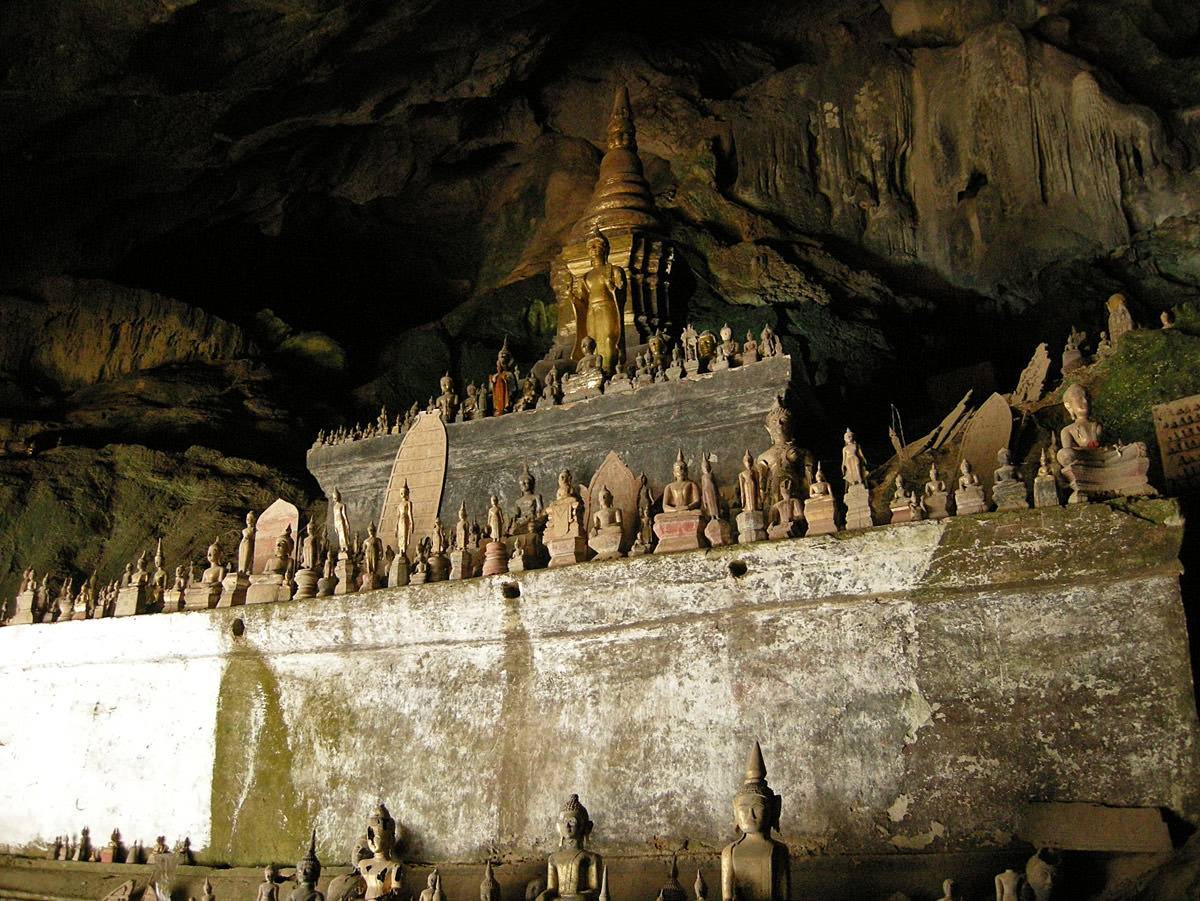
The Pak Ou Buddha Caves - Photo: vietnampathfinder.com
Opposite the Buddha Caves on the far side of the Mekong is the “mouth” of the “Ou” River – “Pak Ou” in Lao. The scenery here at the entrance of the Nam Ou is dramatic, with a huge limestone peak rising up over the junction of the two rivers. South of Pak Ou, on the banks of the Mekong, is a village that produced stoneware jars for thousands of years, but has now forsaken that activity, having found that distilling liquor is more lucrative. The inhabitants of BAN XANG HAI, referred to by local boatmen as the “Whisky Village”, are quite used to thirsty visitors stopping by for a pull on the bamboo straw. The liquor is lào-láo, made from fermented sticky rice, and pots filled with the hooch are lined up on the beach awaiting transport up or down the river.
As it’s logical to see the Pak Ou Caves and the Whisky Village on the same trip, most boatmen hired in Luang Prabang are happy to treat it as a package, assuming that after you’ve seen a cave-full of Buddhas you’ll be ready for a good, stiff drink. Boatmen congregate throughout the day near the slow boat landing and at the tip of the peninsula near Wat Xieng Thong.
6. Kouang Si Waterfall
One of the best day-trips from Luang Prabang is Kouang Si waterfall, a picturesque, multi-level affair that tumbles 60m before spilling through a series of crystal-blue pools. The spray from the falls keeps the surrounding grounds cool even at midday. It’s a great spot for a picnic and a refreshing swim – there are picnic tables and changing rooms at the site. The upper pool has a nice view of the falls, though swimming is only allowed at the lower pool, which lacks a direct view. If you didn’t pack lunch, pay a visit to the vendors nearby selling tam màk hung, fruit and drinks.
Photo: popsugar.com
If you’re up for some exercise, the steep path on the opposite side of the falls leads to the top and a grassy meadow filled with brilliantly coloured butterflies. Tread carefully though, as the path can get quite slippery; more than a few barefoot trampers have slipped and broken a leg here.
There are several options for getting to the waterfall, which is situated 35km southwest of Luang Prabang. The most scenic approach is by boat down the Mekong River; the same boatmen who run the trips to the Pak Ou Caves will take you to the falls, the final portion of the journey is by tuk-tuk, which is usually worked into the fee by the boatman – check when negotiating. Alternatively, it’s possible to get there by road – tuk-tuk drivers in town will usually approach you about this, or head to the “Tuk-tuk Station Travel Service” in Luang Prabang.
7. Tad Sae Waterfall
Tad Sae waterfall is a spectacular natural wonder best appreciated in the wet season. Despite not being as high as Kuang Si waterfall there are many more streams of water which cascade and make a thunderous sound following plenty of rain. The falls pour over beautiful limestone formations across a variety of levels into large pools below, which are fantastic to swim in.
Tad Sae is only reached by boat, making it quite an adventure and an opportunity to retreat into nature and get close to the locals who head there in groups over the weekend. If you prefer peace and tranquillity then you’re better off visiting during the week. The water is cool, offering swimmers a refreshing dip which is best experienced from August through to November. If you’re visiting Luang Prabang at any other time then head to Kuang Si waterfall instead.
: treasuresofindochina.com
The cascades of Tad Sae offer really great photo opportunities as the water teems over the multi-levelled rocks into the pools below. There are steps leading into the largest pool making swimming access really easy. The pools are very popular with locals and it’s best to dress modestly like them, especially if swimming. There are public toilets and changing facilities at the waterfall and also a restaurant with a small resort attached nearby.
Most locals bring something to sit on and enjoy a picnic close to the falls where there are also a few waterwheels. The waterfall is located about 20km away from the centre of Luang Prabang but it’s definitely worth a trip during rainy season, outside of this time the falls are pretty dry and most likely will prove disappointing. The waterfall is located close to the Ban Amen village on the Nam Khan River. It’s a ten-minute boat ride from there to Tad Sae.
8. Wat Wisunarat (Wat Visoun)
Dating back to 1513 and the reign of King Wisunarat (Visoun), Wat Wisunarat is Luang Prabang’s oldest temple and was once home to the Prabang Buddhas. The history of the temple is colourful with it being originally crafted from wood before being burned by Black Haw riders in 1887. The Black Haw riders were part of the Black Flag military rebel group led by a Chinese commander at the end of the 1880s. Post invasion, it was rebuilt using stucco and brick and retains some original pieces including a stupa that was created in 1503 along with some other small Buddha icons although many were stolen during the Haw raid.
Over the years the temple has also acted as a Museum of Religious Arts and as such now homes an array of religious artefacts and precious items relating to both Buddhism and the royal family. The temple is a celebration of early Lao architecture with wooden windows reflecting the Wat Phou Temple in the South of the country coupled with stucco work that is classic Luang. Restoration work was carried out in 1895 and then again in 1932.
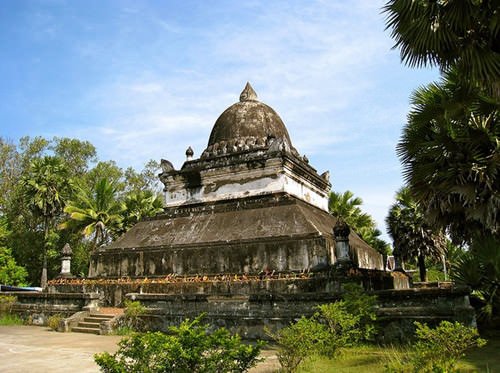
Photo: dulichviet.com.vn
The Wisunarat temple is home to a small selection of richly gilded Buddhas and some ancient stones dating back to the 15th century. The stones were donated by Prince Phetsarat following the Black Haw bandit invasion. The Haw left with most of the priceless Buddha images made from jade, gold and precious gems by breaking open the stupa. Prior to invasion, Wat Wisunarat was once home to the revered Pha Bang Buddha from 1507 to 1715 which can now be viewed at the Royal Palace Museum.
One of the temple’s most unique features is its unusually shaped stupa designed by the wife of King Wisunarat to be a lotus flower but referred to by locals as ‘the watermelon stupa’. Another distinguishing highlight is the European-style roof which slopes in a manner not usually seen in Laos. This is largely due to the French architects who helped with the rebuilding in the late 1980s. The temple is still functioning today and is open to visitors with plenty of information available about its fascinating history.
9. Wat Long Khoun
esting close to the river on the banks of the Mekong, Buddhist temple Wat Long Khoun has long and historically significant connections to the Luang Prabang royal family. Also known as the ‘Monastery of the Happy’ the temple once served as a sanctuary for those seeking spiritual rejuvenation including any new king who would retreat to the Wat for three days cleansing and meditation prior to his coronation at Wat Xieng Thong.
Wat Long Khoun is typical of local Luang Prabang architecture of the 18th century with two single level sections; the front part however was extended in 1937 as instructed by the then-reigning King Sisavonvang. This section is more elaborate in style and features gilded columns and intricate wood carvings.
Photo: luangprabangtravelnow.com
The older part contains Jataka murals which still retain some of their original vibrancy telling the story of the 547 lives of Lord Buddha. The murals also feature local myths and legends incorporating Buddhist morals of kindness and the importance of giving. Unfortunately, revolutionary vandalism in the 1970s and damp weather resulted in some damages to the murals.
Built in the 18th century, Wat Long Khoun lies almost directly opposite to Wat Xieng Thong and was recently restored by workmen careful to use traditional techniques and materials. Renovation work was much needed as the temple was left in a state of disrepair when the monarchy was disbanded; the work was taken out by the Lao Department of Museums and Archaeology with the assistance of the Ecole Française d’Extrême Orient who went to great lengths to keep it as authentic as possible.
The original meditation room once used by kings is still intact along with the living quarters for monks built as a traditional wooden outhouse. Entrance to the 1937 portico is guarded by two large Chinese statues with the entire porch being supported by eight elegant black-and-gold columns topped with lotus petal designs. Inside, the temple features decorative deities and a variety of other statues and carvings including a red ceiling with dharma wheels, peacocks and mythical creatures intricately stencilled on.
10. Traditional Arts & Ethnology Centre
Luang Prabang’s Traditional Arts & Ethnology Centre is dedicated to the preservation and celebration of the many ethnic groups existing in Laos both today and in the past. This cultural display of arts and lifestyles reflect a very diverse ethnic population. Permanent exhibitions feature traditional textiles and clothing, jewellery, religious artefacts, handicraft tools, baskets, photography and household objects.
The museum offers visitors a rare glimpse into the life of Laotian people giving a greater understanding to their richly diverse culture with quotes, photos and videos bringing the exhibits to life. Located in a restored heritage building, it is the only non-profit museum in Laos solely committed to interpreting and preserving the lives of the country’s ethnic groups.
Photo: indochinavoyages.com
The centre is small in size but packed with interesting and informative pieces which are organised to an international standard. The museum shop operates on a fair-trade basis by providing local craftsmen and women with an opportunity to sell their hand-made goods with a stock of around 500 products supporting a number of families across Laos.
There are over 400 exhibits documenting the life and times of 30 ethnic groups at the Traditional Arts & Ethnology Centre all supporting Laos’ varied cultural heritage. Reconstructions of domestic existence deliver a unique insight into everyday life alongside displays of religious and ceremonial items. Permanent exhibitions include the subgroups of the Akha people which feature a headdress comprising more than 300 pieces of antique Indochinese silver. The Kmhmu display portrays bamboo basketry in a Kmhmu home featuring baskets and back strap looms.
Special exhibitions at the museum are well worth a visit and often showcase ceremonies and rituals such as the recent “From Courtship to Kinship: Wedding Celebrations of Laos’ Ethnic Groups”. Displays at the Courtship to Kinship exhibit included the wedding crown of Kim Di Mun which was crafted from human hair and pure silver, superb documentary-style photography and detailed explanations of the customs and rituals added to the depth of this acclaimed exhibition.
11. The living land company
The Living Land Company is a community-run organic farm supplying fresh vegetables, herbs, salads and rice to hotels and restaurants in Luang Prabang. Visitors can take a trip to the farm and try their hand at being a farmer with an opportunity to grow rice and enjoy a beautiful Lao-style house overlooking rice terraces and the organic vegetable fields. The farm aims to offer an alternative to the current slash-and-burn farming methods which result in unusable land following harvest.
Being organic there are no chemicals used and the Living Land Company follows a strict policy of composting and crop rotation to ensure the continued use of the land which ensures it remains fertile. Struggling local families are invited to work on the farm where there are also student scholarships in place. The families benefit hugely from the income in an area that provides very little in the way of work, and the eating establishments in Luang Prabang reap the rewards of superior tasting fresh chemical free produce for their guests.
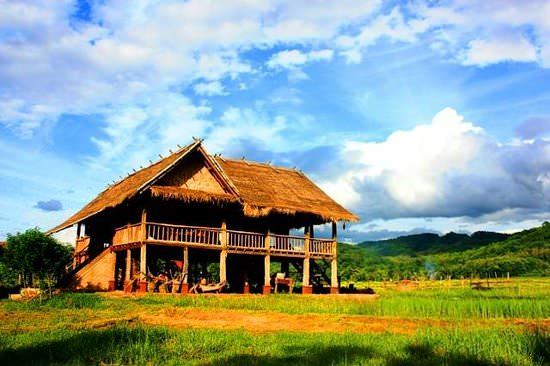 Photo: tripadvisor.com
Photo: tripadvisor.com
The whole family can enjoy time spent at The Living Land Company trying their hand at traditional Lao rice farming methods. You’ll be taught about ancient rice harvesting and planting methods and also all about threshing and winnowing rice. Alternatively you can combine time at the farm with a cooking lesson given by a hotel’s head chef creating clay-pot soup, curry paste and sticky rice steamed in a huat kao basket. The class takes place in a picturesque open-air wooden pavilion in the middle of the vegetable fields with grazing buffalo and rolling hills close by.
Wine is also included in the lunch which starts with a tour of the farm. The Living Land Company organic farm stretches over two hectares cultivating all manner of herbs and vegetables including beetroot, mint and mustard with an additional eight hectares of rice paddies. There are future plans currently underway to add a flower and a fish farm to the company.
12. Luang Prabang Library
The Luang Prabang Library is a wonderful place to visit and offers the chance for you to give something back to the children of Laos. Many of the children here will be lucky if they ever get to even hold a book which is literally an unaffordable luxury for poor families and schools. In many of the villages, schools themselves are a rarity.
The library works towards providing reading materials to kids in some of the more remote areas by operating two library boats which deliver books to 75 different villages along the Mekong. The boats can only operate due to donations with just $2US buying a book. However if you were to increase that donation to the region of a few hundred dollars, then you will also get the opportunity to pay for fuel and teaching on the boat for a couple of weeks and the chance to get on board and see how your money is being spent.
Photo: tripadvisor.com
Tourists are invited to keep the Luang Prabang Library boats on the water and delivering books to schools. You can participate by dropping off a book which the library will then sell on to raise more funds. Alternatively you can buy a map or a souvenir at the library or even buy books to go in a book bag that will be sent to a village.
If you want to bring some books for the children then try and make sure they are school text books. In addition to the boats there are also book bags given to more than 100 surrounding villages with weekend reading activities also taking place for the Khmu schools. The book bags are made from quilted material with pockets in which to place the books, there is a strap attached for the bag to be hung from a tree as there are often no shelves available at the school or village.
13. Elephant Village Sanctuary
Close to the banks of the Nam Khan River, the Elephant Village Sanctuary (also known as the Elephant Park Project) works towards providing a peaceful future for rescued Lao elephants. Starting by saving the elephants from often brutal logging work, they are then given a home in the jungle where they can rest and recover. Some of the elephants at the sanctuary are disabled and are offered a chance of rehabilitation with an onsite fulltime vet to help those in need.
The village is located in a lush river valley which is on a long government lease so long as the sanctuary opens its doors for tourists to see the programme. Excursions are offered through Tiger Trail Outdoor Adventures and include elephant riding and a mahout experience with anything from a half-day to a two-day tour. Whatever trip you book will go towards ensuring the existence of this sanctuary benefiting both animals and the 40 staff employed from the local villages that would otherwise be most likely without work.
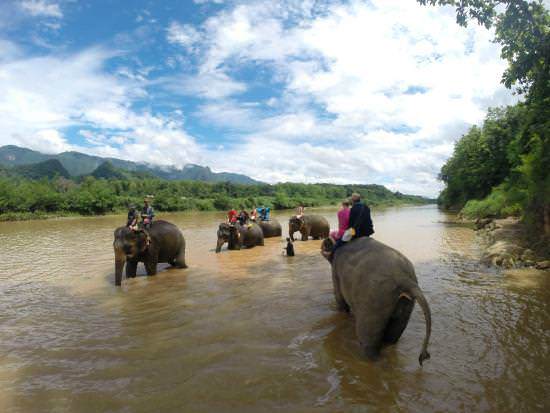 Photo: tripadvisor.com
Photo: tripadvisor.com
The Elephant Village Sanctuary offers a once-in-a-lifetime experience to get really up close and personal with these magnificent creatures. A one-day mahout tour includes basic mahout training in how to control an elephant, a one-hour elephant ride through the jungle and also a trip to the Tad Sae waterfall located close by. This experience can be extended into two days with the additional opportunity to bathe ‘your’ elephant in the Nam Khan River plus an evening ride to take the elephant to their jungle home. There is also a full day elephant excursion which includes trekking the ‘Train of Falls’ - the natural mountain stream that provides the water to the Tad Sae Waterfall.
If you’re feeling more energetic you can also combine your trip with a bike ride where you cycle from a forest temple through villages to the sanctuary before stopping by the waterfall, or with three hours kayaking downstream following your elephant ride. All tour programmes include lunch and refreshments plus accommodation where applicable.
14. Ban Phanom
Ban Phanom is a village steeped in traditional textile making with all families in the village working their looms to provide goods for sale at the night markets. The woven products were once supplied to the royal family and weavers today use the same techniques and patterns, resulting in a distinctly old-fashioned look. Cotton and silk materials with a range of coloured threads are intertwined to produce a shimmering effect whilst silk is added to create a pattern.
Some of the families work from their own small workshops with the whole village operating as a co-operative supplying to a handful of manufacturers. Prices are open to negotiation and very affordable, you will need to bargain and expect not to pay the first price offered. In addition to shopping and enjoying a cultural experience, the area around Ban Phanom makes for a great place to take a bike ride and to explore some ancient remote temples.
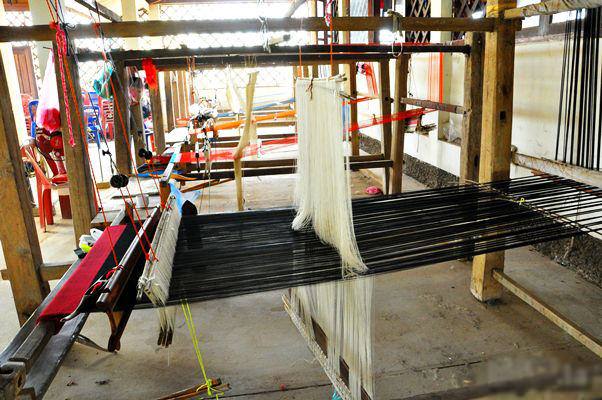 Photo: peacetour.com.vn
Photo: peacetour.com.vn
Close to the Phon Phau Temple, the village of Ban Phanom makes a popular tourist stop and is similar to the villages of Luang Namtha and Sam Neua as there you can observe the female textile makers at work on their looms, dyeing and then weaving. Years ago Ban Phanom was the village of choice for royal textiles, with each reigning monarch continuing to use village weavers as their preferred suppliers.
The village itself is rich in history and offers a fantastic insight into an ancient art that is still very much alive today, thanks to tourism. Many sightseers visit the village, so it can get quite busy, especially when coaches arrive between 09:00 and 10:00, so avoid these times and you'll probably experience a much more relaxed trip. If you’re interested in buying some textiles as a souvenir then it’s definitely worth visiting here instead of buying at the night market.
15. Alms Giving Ceremony
The UNESCO World Heritage City of Luang Prabang is the perfect place to see one of the most sacred Lao traditions, the Buddhist Alms Giving Ceremony. Despite being a highly revered ritual for locals, visitors are encouraged to be involved as long as a level of respect is maintained throughout.
Alms giving takes place daily as the sun rises, beginning on the main street of Luang Prabang before spreading out to all the side streets. You should buy your offerings (usually food) in advance and arrive with plenty of time to spare as it’s considered very offensive to disrupt the ceremony once it has commenced.
Photo: telegraphh.co.uk
Follow the guidance of the locals by kneeling down ready to give your offering to the monks; most common gifts include rice, fresh fruit and traditional sweet snacks. The idea of the alms giving is for the Buddhist monks to make merit and also to collect food for their one meal of a day.
As the sun rises in Luang Prabang around 200 Buddhist monks depart from their various temples to gather their daily meal. The tradition of alms gathering dates back to the 14th century, yet still today locals wake early to prepare the food for the monks and wait quietly by the roadside to give their gifts. Although the main purpose is for locals to give alms to the monks, you will also notice small children kneeling with baskets in the hope that the monks will share some of their alms with them so that they can take food back to their family.
This daily ceremony is both peaceful and spiritual and gives you a wonderful opportunity to experience an ancient Lao tradition. The procession is quite lengthy and therefore not suitable for very young children or those who cannot sit quietly for more than a few minutes. If you are taking photographs it is best to step back from the front of the line to avoid causing offence. If you are not making an offering maintain an appropriate distance and do not under any circumstances get in the way of those making an offering. Visitors should also remember to be there before the monks arrive and never ever to follow the procession.
There are many unspoken rules regarding etiquette when attending an Alms Giving Ceremony, firstly shoulders, chests and legs must be covered in modest clothing as a mark of respect. You should also remain at a suitable distance from the monks and do not interrupt the procession under any circumstances. Therefore photographs may be taken, but from a distance and never use a camera flash.
When seated, shoes and socks must be removed with your feet tucked underneath as you observe the ceremony in absolute silence. Female attendees must keep their head lower than the monks when giving alms and they must not talk to or touch the monks at any time, even when making an offering. Suitable offerings include some simple food which you can probably arrange at your hotel or buy from a local market en-route, if you buy alms on the street do not negotiate on price as this is also considered highly disrespectful.
If you are planning to visit Luang Prabang, please don not hesitate to contact us! Email us: info@ahomevietnam.com!